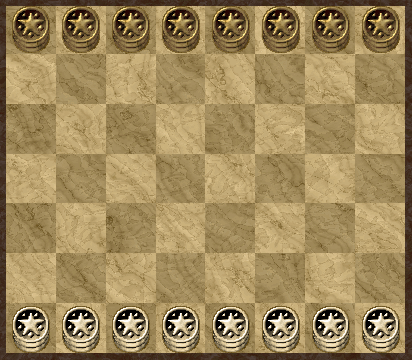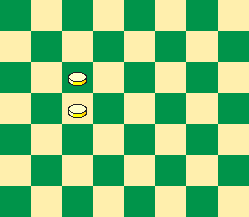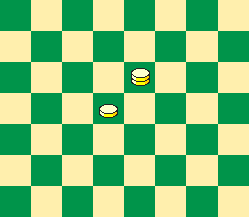

The game is played on a 8 x 7 board with 16 counters for each side,
initially stacked upon each other in doubles. The double is called Tower
and the singleton is called Wall. The latter cannot move. The Tower changes to two Wall pieces by
distributing them two steps in any direction. Should a friendly Wall occupy any of
the squares, then a singleton is stacked upon it, which means that it turns
into a Tower. A Tower may also capture an adjacent enemy Wall by
sacrificing its topmost singleton. Thereby a Wall remains
on the original square. White represents the Romans and Black represents the
Gauls. White moves first. Win is achieved by either placing a singleton
onto the opponent’s home row or by stalemating the opponent.
Murus Gallicus was invented in 2005 by Phil Leduc. The name refers to
the stone walls used in the Gallic wars that took place in Gaul, now modern
day France. One may distribute a Tower so that a friendly Wall on the
second square becomes a Tower. Try to use this double movement for
offensive maneuvers. Although Wall placement is mostly for defensive
blocking, remember that a Wall can act as a stepping stone for double
movement. A variant called Advanced Murus Gallicus, featuring the Catapult, has also been implemented.
Examples
 In this example, the
Tower goes north and distributes the two singletons according to the
following diagram.
In this example, the
Tower goes north and distributes the two singletons according to the
following diagram.
 The Tower has become
two singletons that cannot move.
The Tower has become
two singletons that cannot move.
 If the Tower goes NE, it drops one singleton on
the way and places the other on top of the friendly Wall.
If the Tower goes NE, it drops one singleton on
the way and places the other on top of the friendly Wall.
 The result is that the Tower has transported
itself two steps.
The result is that the Tower has transported
itself two steps.
References
‘Murus Gallicus (game)’. Wikipedia article. (here)
Ploog, D. (2009). ‘Murus Gallicus’. (here)
Leduc, P. (2009). ‘Murus Gallicus’. (here)
☛ You can download my free Murus Gallicus program
here (updated 2022-05-20), but you must own the software
Zillions of Games to be able
to run it. (I recommend the download version.)
☛ Don’t miss my other chess
variants.
© M. Winther (May 2022).